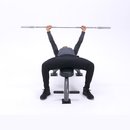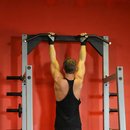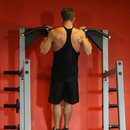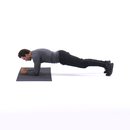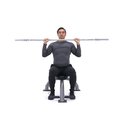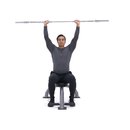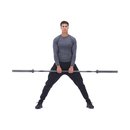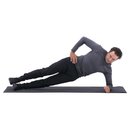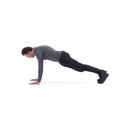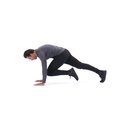Vital Stats
- Name: Jon-Erik Kawamoto, CSCS, CEP
- Owner: Personal Trainer & Fitness Writer
- Website: JKConditioning.com
Take a moment to imagine this frustrating and, unfortunately, extremely common scenario: You bust your ass in the gym nearly every day, and you never miss a beat in your weekly workouts. High-intensity interval training, 5-mile runs, 4-day splits, CrossFit—you name it, you've tried it. Eight weeks pass and, for all your time and effort, you barely have anything to show for it—no PR numbers to brag about, and no awesome changes in the mirror.
If this sounds like you, there's no reason to fear. In my experience, a lack of any visible progress is due to a few controllable factors. People who aren't adapting physically often:
- Work out too few or too many days
- Exercise with the wrong or inconsistent intensity
- Give little regard to the actual exercises they perform
- Do the wrong exercises for their goals
High-intensity interval training, 5-mile runs, 4-day splits, CrossFit—you name it, you've tried it. You bust your ass in the gym nearly every day, but do you have anything to show for it?
It just so happens that these factors together make up what is called the FITT principle. It's a training template that's designed to narrow your program's focus based on your training goals, current level of fitness, and the type of equipment you have access to. FITT stands for Frequency, Intensity, Type, and Time. The principle will help you troubleshoot your workout program, so let's get you back on the right path toward the physique, strength, or performance goals you've always wanted!
F = Frequency Of workouts per week
The first component of the FITT principle refers to the number of days you can actually work out in a week. It's not a complicated algorithm, but it's generally based on your schedule and how well you can recover between workouts. Choose a realistic frequency that you can stick with from week to week—once or several times per week, for example.
At the same time, you'll need to adjust expectations of your results based on how closely you can stick to your plan. You can't expect to be shirtless material for a magazine cover with only one workout per week, but one day certainly beats zero days. On the flipside, training all the time with inadequate time for recovery can also impair your progress. Typically, most people will see worthwhile results when consistently training 3-5 times per week.
I = Intensity of each workout
Intensity can be measured via one or more of the following:
- The total weight (or load) used (e.g. 100 vs. 200 pounds on a bench press)
- Heart rate (e.g. 60 beats per minute versus 180 beats per minute)
- Work periods (e.g. 20-seconds of work versus 60-seconds work)
- Rest periods (e.g. 60-seconds rest versus 20-seconds rest)
Your personal intensity level should be determined by your current fitness level and the effect you want from your workouts. Training with different intensities can lead to different training effects depending on the mode of exercise. Let's go over a few examples for a few different modes of exercise.
Prilepin's Chart below helps determine how much weight to use and the general set and rep scheme, according to your goals.
Prilepin's Chart
- Endurance and Explosive Strength: <70% max, 15+ reps, 1-4 sets
- General Strength: 70-80% max, 10-15 reps, 1-5 or more sets
- Hypertrophy: 75-85% max, 8-12 reps, 1-5 or more sets
- Max Strength: 85-100% max, 1-5 reps, 1-5 or more sets
If your goal is to build muscle (hypertrophy), the suggested weight is between 75 and 85 percent of your maximal effort with 1-5 sets of 8-12 reps. This is the typical bodybuilding-style rep scheme you might be familiar with.
Heart Rate Training
- Aerobic Endurance: 60-75% of maximum heart rate
- Stamina (threshold training): 80-85% of maximum heart rate
- Economy (VO2 max training): 85-95% of maximum heart rate
For people who want to improve their aerobic performance, heart rate training is the most effective way to measure or improve your fitness, endurance, and stamina. Know your max heart rate and current heart rate (as measured in beats per minute), and train in the target zone outlined in the table above for a particular training effect.
Know Your Max Heart Rate
You can monitor heart rate either by manually checking your pulse or using a heart rate monitor. Knowing your heart rate will allow you to exercise within your target "heart rate zone."
Heart rate-training first involves knowing your maximum heart rate (MHR). Typically, this can be roughly estimated with a simple equation: 220 minus your age. If you really want to elevate your training results, you'd probably want to get it tested with the help of a personal trainer or lab.
Last, instead of counting reps, you can perform an exercise for a certain amount of time, called timed-set training. If you're going to perform one exercise after another within a circuit then this method of training works well. This type of training is popular among CrossFit. A longer work period is obviously going to be more difficult compared to a shorter work period. The inverse holds true for a shorter rest period. Shortened rest is going to be more difficult compared to longer rest.
Rest Period Variances
- Strength: 2-5 minutes
- Power: 2-5 minutes
- Hypertrophy: 30-90 seconds
- Endurance: <30 & up to 60 seconds
T = Time Under tension and duration of workouts
Time here applies to how long your muscles actually work and the total duration of your workout. When you lift weights, your muscles undergo stress and tension. Whether you move weights quickly or slowly, the speed affects how long tension is placed on a muscle or a set of muscles. The longer your muscles are placed under tension, the stronger the signal is for hypertrophy.

"Speed affects how long tension is placed on a muscle. The longer your muscles are placed under tension, the stronger the signal is for hypertrophy."
If your goal is bodybuilding and muscular development, you should be holding muscles under a longer duration of tension, such as taking 2-3 seconds to perform the up and down phase of an exercise. According to the table below, the inverse holds true for developing explosive power and strength.
To Develop Power and Strength
- Strength: 1-2 seconds for the down phase, as short as possible for the up phase
- Power: 1-2 seconds for the down phase, 1 second for the up phase
- Hypertrophy: 2-5 seconds for the down phase, 2-3 seconds for the up phase
- Endurance: 1-2 seconds for the down phase, 1-2 seconds for the up phase
The other meaning of this "T" represents the length of your workout. Since you now know the adequate rest periods and workout intensity for your desired training effect, you can accomplish a rewarding workout within 45-75 minutes—granted that you know the type of exercises to perform, as well.
T = Type Of exercise
Your actions or movements during training determine the training outcome. If you want to be a fast runner, you have to run. If you want to build muscle, you have to exercise in the muscle-building rep range, intensity, and rest periods. If you want to lose fat, you have to eat a calorie deficit and train with that intent. The list goes on!
To build strength and muscle, I recommend beginners perform mostly full-body, multi-joint exercises that take your joints through the body's optimal range of motion. The rest of the program can be padded with accessory and isolation exercises such as biceps curls and triceps press-downs.

Leg Press
Many novice lifters will benefit from performing three full-body workouts per week, with each workout including these movement patterns:
- Pushing Exercise: bench press, push-up, overhead press
- Pulling Exercise: chin-up, row, lat pull-down
- Squat: back squat, leg press
- Hip Hinge: deadlift, hip thrust, kettlebell swing
- Core Stability: plank, carry
Here is a sample workout plan consisting of two workouts that can be alternated and performed three times a week.
Put It All Together
When it comes to building an exercise program for your personal goals, you can't just show up at the gym and expect your body to change. Invest a significant amount of thought into a realistic training frequency, the intensity of your workouts, the total time under tension and workout duration, and the type of exercises and training you do. When you keep the FITT principle in mind, you'll be able to find the sweet spot of a well-structured and balanced workout plan that will fit your own goals and needs!



